BSBMGT605: Providing Leadership Across the Organisation - Full Report
VerifiedAdded on 2024/05/16
|26
|6301
|172
Report
AI Summary
This BSBMGT605 report provides a detailed analysis of leadership across an organisation, focusing on ethical leadership, its characteristics, and benefits. It discusses various leadership styles and their impact on organisational culture, along with strategies to encourage employee participation in decision-making and build trust. The report also covers the importance of leadership in ensuring work health and safety legislation is met, and the significance of following anti-discrimination laws. Furthermore, it includes a presentation that outlines a strategic plan for expanding a business, addressing market characteristics, objectives, operational priorities, and risk management strategies. The presentation also identifies specific activities and allocates responsibilities based on staff roles and competencies.
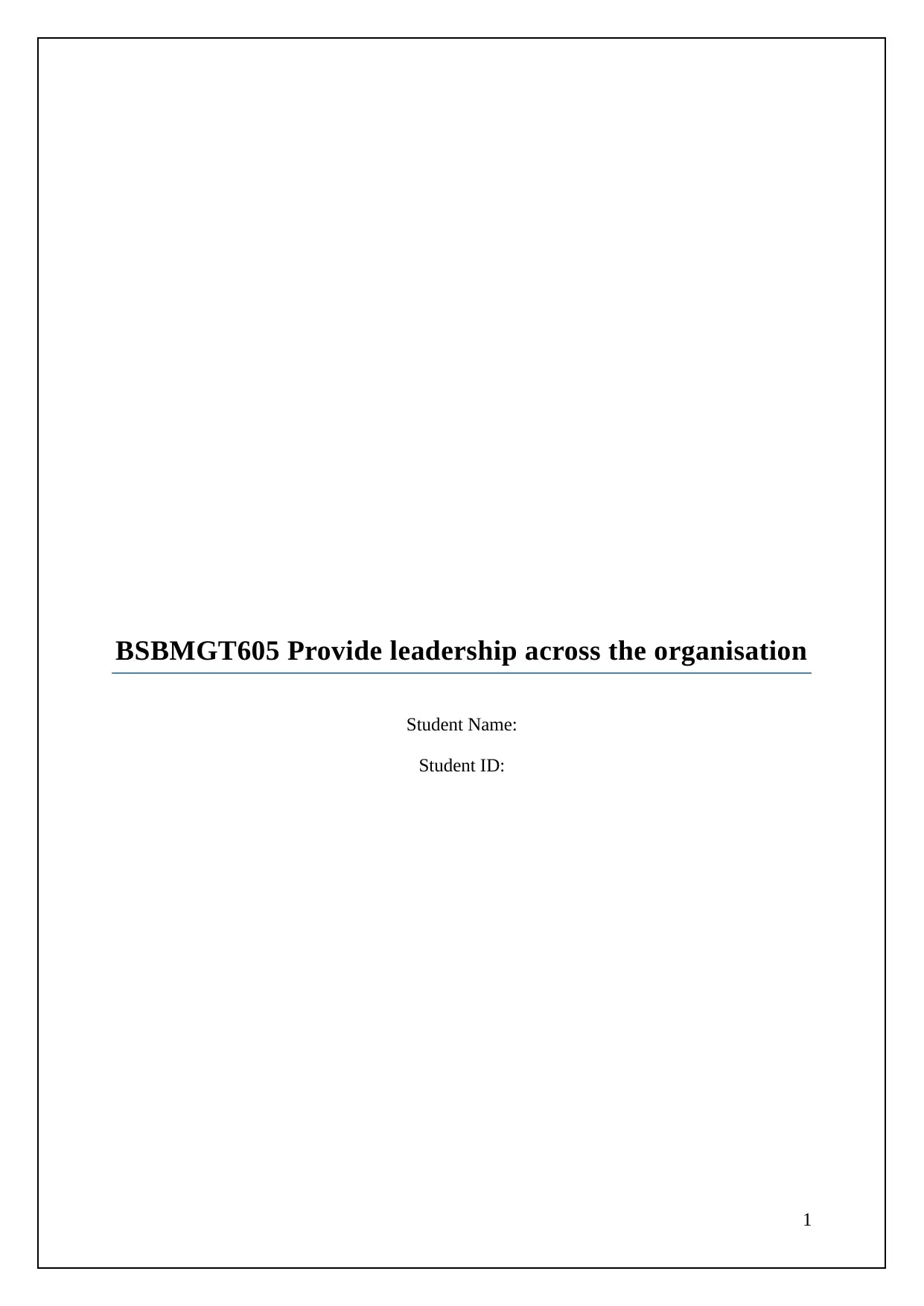
BSBMGT605 Provide leadership across the organisation
Student Name:
Student ID:
1
Student Name:
Student ID:
1
Paraphrase This Document
Need a fresh take? Get an instant paraphrase of this document with our AI Paraphraser
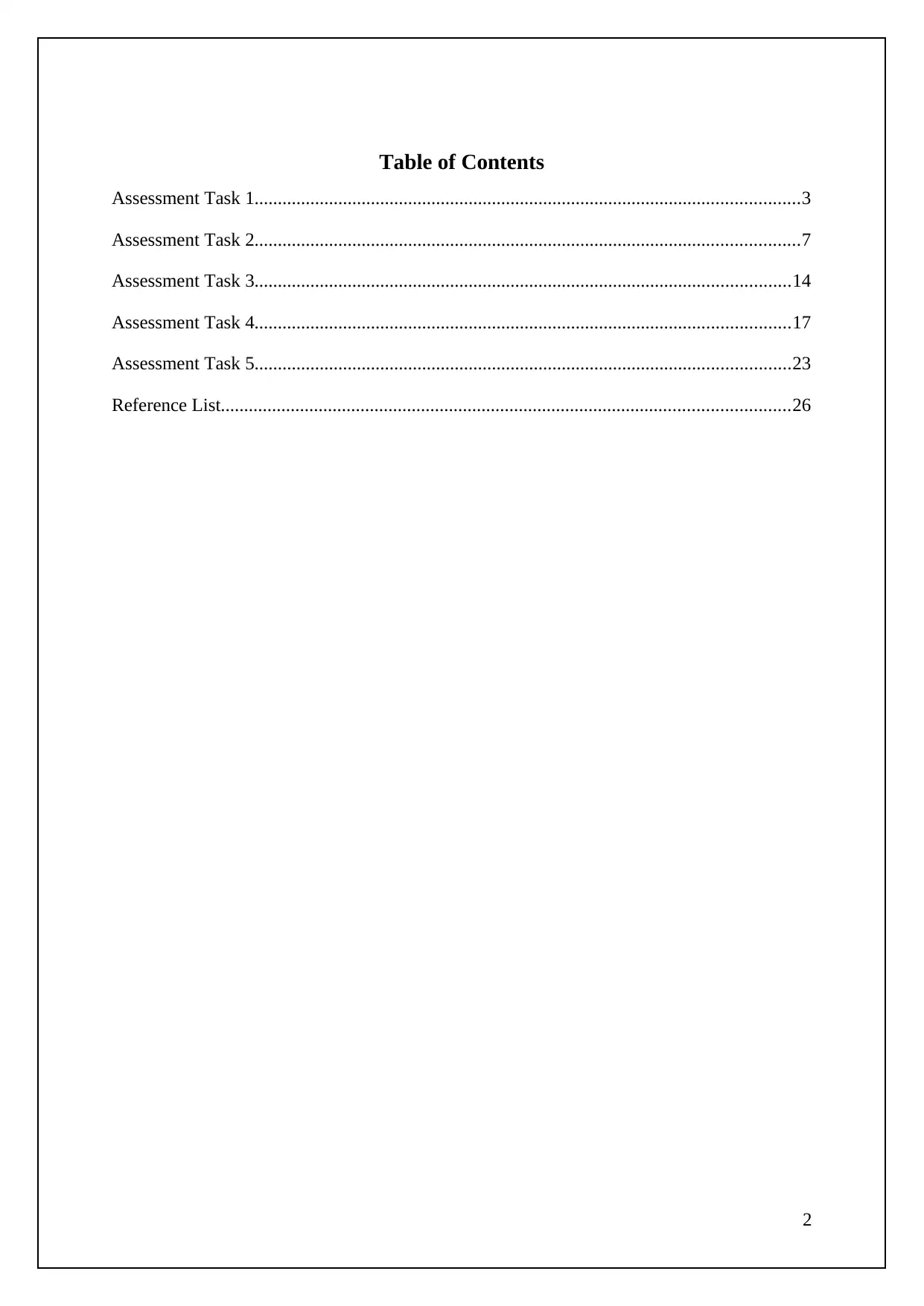
Table of Contents
Assessment Task 1.....................................................................................................................3
Assessment Task 2.....................................................................................................................7
Assessment Task 3...................................................................................................................14
Assessment Task 4...................................................................................................................17
Assessment Task 5...................................................................................................................23
Reference List..........................................................................................................................26
2
Assessment Task 1.....................................................................................................................3
Assessment Task 2.....................................................................................................................7
Assessment Task 3...................................................................................................................14
Assessment Task 4...................................................................................................................17
Assessment Task 5...................................................................................................................23
Reference List..........................................................................................................................26
2
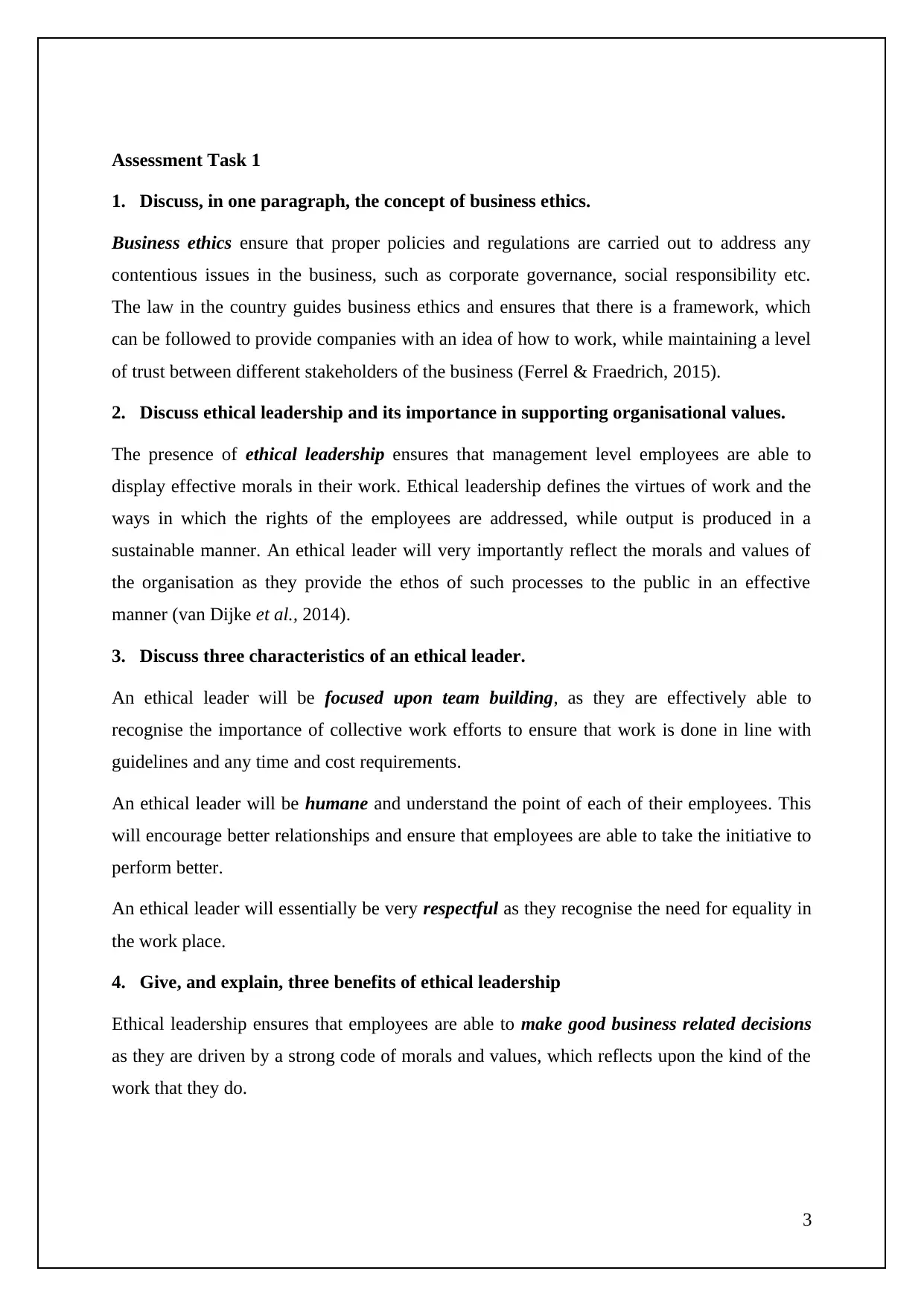
Assessment Task 1
1. Discuss, in one paragraph, the concept of business ethics.
Business ethics ensure that proper policies and regulations are carried out to address any
contentious issues in the business, such as corporate governance, social responsibility etc.
The law in the country guides business ethics and ensures that there is a framework, which
can be followed to provide companies with an idea of how to work, while maintaining a level
of trust between different stakeholders of the business (Ferrel & Fraedrich, 2015).
2. Discuss ethical leadership and its importance in supporting organisational values.
The presence of ethical leadership ensures that management level employees are able to
display effective morals in their work. Ethical leadership defines the virtues of work and the
ways in which the rights of the employees are addressed, while output is produced in a
sustainable manner. An ethical leader will very importantly reflect the morals and values of
the organisation as they provide the ethos of such processes to the public in an effective
manner (van Dijke et al., 2014).
3. Discuss three characteristics of an ethical leader.
An ethical leader will be focused upon team building, as they are effectively able to
recognise the importance of collective work efforts to ensure that work is done in line with
guidelines and any time and cost requirements.
An ethical leader will be humane and understand the point of each of their employees. This
will encourage better relationships and ensure that employees are able to take the initiative to
perform better.
An ethical leader will essentially be very respectful as they recognise the need for equality in
the work place.
4. Give, and explain, three benefits of ethical leadership
Ethical leadership ensures that employees are able to make good business related decisions
as they are driven by a strong code of morals and values, which reflects upon the kind of the
work that they do.
3
1. Discuss, in one paragraph, the concept of business ethics.
Business ethics ensure that proper policies and regulations are carried out to address any
contentious issues in the business, such as corporate governance, social responsibility etc.
The law in the country guides business ethics and ensures that there is a framework, which
can be followed to provide companies with an idea of how to work, while maintaining a level
of trust between different stakeholders of the business (Ferrel & Fraedrich, 2015).
2. Discuss ethical leadership and its importance in supporting organisational values.
The presence of ethical leadership ensures that management level employees are able to
display effective morals in their work. Ethical leadership defines the virtues of work and the
ways in which the rights of the employees are addressed, while output is produced in a
sustainable manner. An ethical leader will very importantly reflect the morals and values of
the organisation as they provide the ethos of such processes to the public in an effective
manner (van Dijke et al., 2014).
3. Discuss three characteristics of an ethical leader.
An ethical leader will be focused upon team building, as they are effectively able to
recognise the importance of collective work efforts to ensure that work is done in line with
guidelines and any time and cost requirements.
An ethical leader will be humane and understand the point of each of their employees. This
will encourage better relationships and ensure that employees are able to take the initiative to
perform better.
An ethical leader will essentially be very respectful as they recognise the need for equality in
the work place.
4. Give, and explain, three benefits of ethical leadership
Ethical leadership ensures that employees are able to make good business related decisions
as they are driven by a strong code of morals and values, which reflects upon the kind of the
work that they do.
3
⊘ This is a preview!⊘
Do you want full access?
Subscribe today to unlock all pages.

Trusted by 1+ million students worldwide
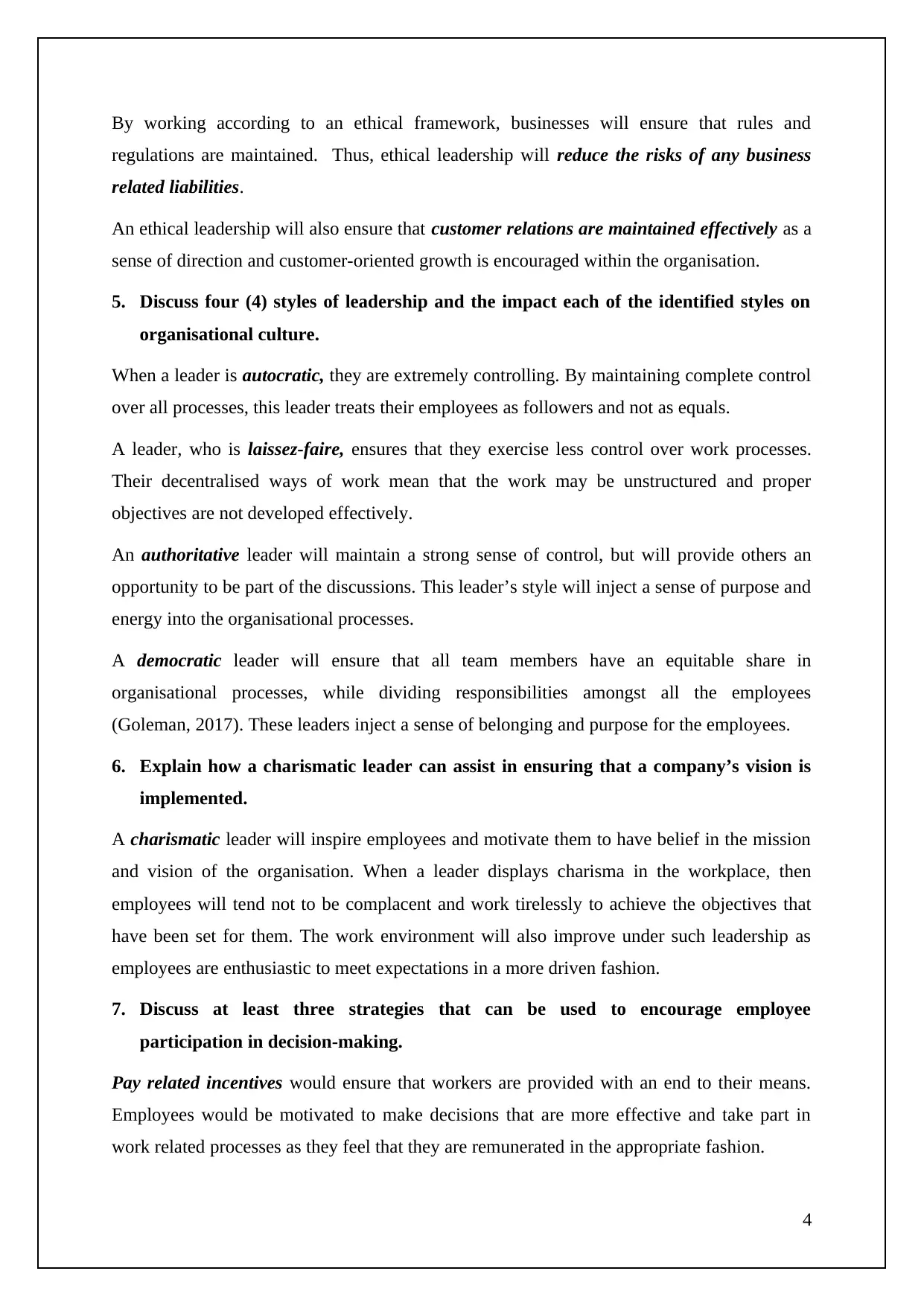
By working according to an ethical framework, businesses will ensure that rules and
regulations are maintained. Thus, ethical leadership will reduce the risks of any business
related liabilities.
An ethical leadership will also ensure that customer relations are maintained effectively as a
sense of direction and customer-oriented growth is encouraged within the organisation.
5. Discuss four (4) styles of leadership and the impact each of the identified styles on
organisational culture.
When a leader is autocratic, they are extremely controlling. By maintaining complete control
over all processes, this leader treats their employees as followers and not as equals.
A leader, who is laissez-faire, ensures that they exercise less control over work processes.
Their decentralised ways of work mean that the work may be unstructured and proper
objectives are not developed effectively.
An authoritative leader will maintain a strong sense of control, but will provide others an
opportunity to be part of the discussions. This leader’s style will inject a sense of purpose and
energy into the organisational processes.
A democratic leader will ensure that all team members have an equitable share in
organisational processes, while dividing responsibilities amongst all the employees
(Goleman, 2017). These leaders inject a sense of belonging and purpose for the employees.
6. Explain how a charismatic leader can assist in ensuring that a company’s vision is
implemented.
A charismatic leader will inspire employees and motivate them to have belief in the mission
and vision of the organisation. When a leader displays charisma in the workplace, then
employees will tend not to be complacent and work tirelessly to achieve the objectives that
have been set for them. The work environment will also improve under such leadership as
employees are enthusiastic to meet expectations in a more driven fashion.
7. Discuss at least three strategies that can be used to encourage employee
participation in decision-making.
Pay related incentives would ensure that workers are provided with an end to their means.
Employees would be motivated to make decisions that are more effective and take part in
work related processes as they feel that they are remunerated in the appropriate fashion.
4
regulations are maintained. Thus, ethical leadership will reduce the risks of any business
related liabilities.
An ethical leadership will also ensure that customer relations are maintained effectively as a
sense of direction and customer-oriented growth is encouraged within the organisation.
5. Discuss four (4) styles of leadership and the impact each of the identified styles on
organisational culture.
When a leader is autocratic, they are extremely controlling. By maintaining complete control
over all processes, this leader treats their employees as followers and not as equals.
A leader, who is laissez-faire, ensures that they exercise less control over work processes.
Their decentralised ways of work mean that the work may be unstructured and proper
objectives are not developed effectively.
An authoritative leader will maintain a strong sense of control, but will provide others an
opportunity to be part of the discussions. This leader’s style will inject a sense of purpose and
energy into the organisational processes.
A democratic leader will ensure that all team members have an equitable share in
organisational processes, while dividing responsibilities amongst all the employees
(Goleman, 2017). These leaders inject a sense of belonging and purpose for the employees.
6. Explain how a charismatic leader can assist in ensuring that a company’s vision is
implemented.
A charismatic leader will inspire employees and motivate them to have belief in the mission
and vision of the organisation. When a leader displays charisma in the workplace, then
employees will tend not to be complacent and work tirelessly to achieve the objectives that
have been set for them. The work environment will also improve under such leadership as
employees are enthusiastic to meet expectations in a more driven fashion.
7. Discuss at least three strategies that can be used to encourage employee
participation in decision-making.
Pay related incentives would ensure that workers are provided with an end to their means.
Employees would be motivated to make decisions that are more effective and take part in
work related processes as they feel that they are remunerated in the appropriate fashion.
4
Paraphrase This Document
Need a fresh take? Get an instant paraphrase of this document with our AI Paraphraser
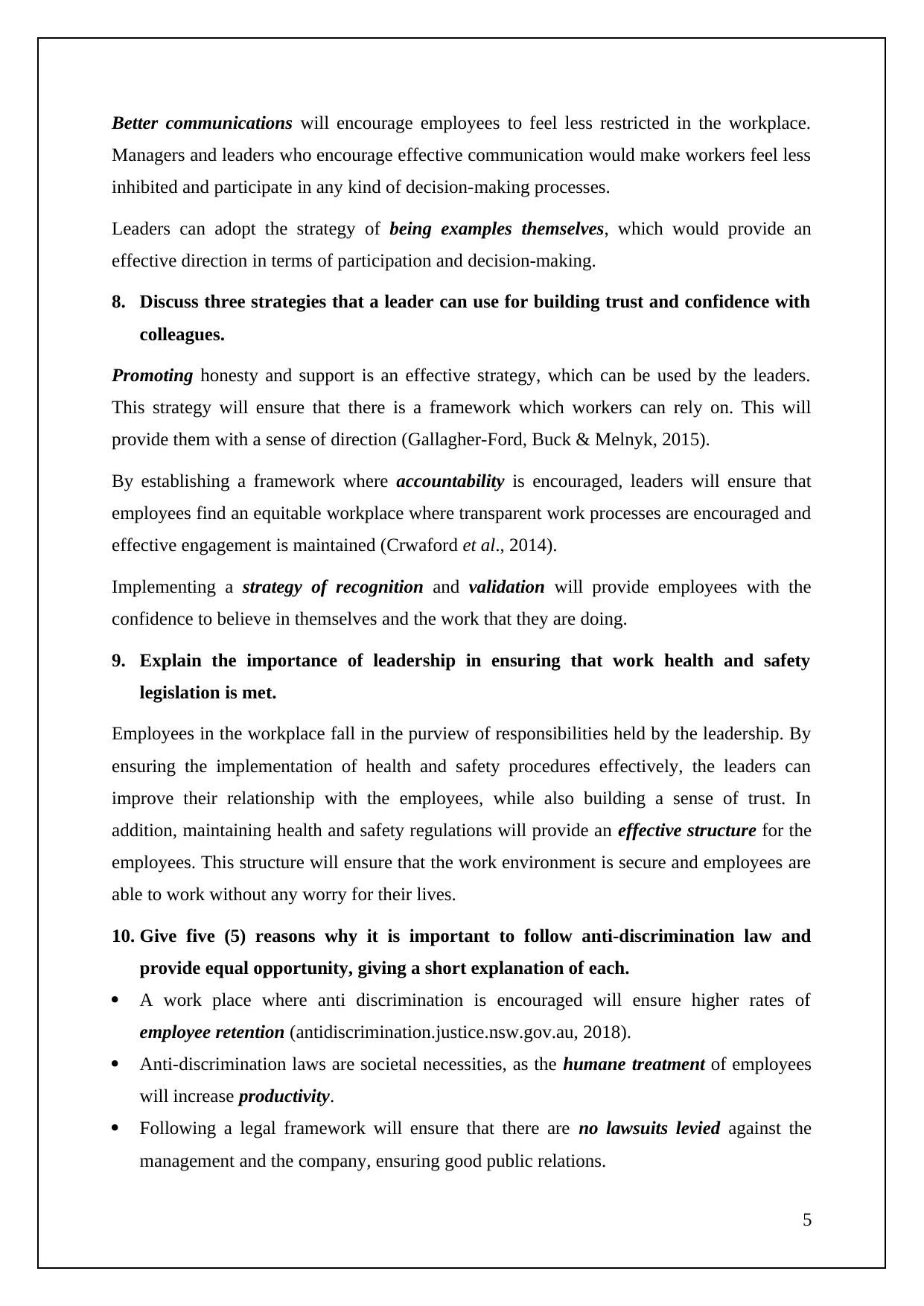
Better communications will encourage employees to feel less restricted in the workplace.
Managers and leaders who encourage effective communication would make workers feel less
inhibited and participate in any kind of decision-making processes.
Leaders can adopt the strategy of being examples themselves, which would provide an
effective direction in terms of participation and decision-making.
8. Discuss three strategies that a leader can use for building trust and confidence with
colleagues.
Promoting honesty and support is an effective strategy, which can be used by the leaders.
This strategy will ensure that there is a framework which workers can rely on. This will
provide them with a sense of direction (Gallagher-Ford, Buck & Melnyk, 2015).
By establishing a framework where accountability is encouraged, leaders will ensure that
employees find an equitable workplace where transparent work processes are encouraged and
effective engagement is maintained (Crwaford et al., 2014).
Implementing a strategy of recognition and validation will provide employees with the
confidence to believe in themselves and the work that they are doing.
9. Explain the importance of leadership in ensuring that work health and safety
legislation is met.
Employees in the workplace fall in the purview of responsibilities held by the leadership. By
ensuring the implementation of health and safety procedures effectively, the leaders can
improve their relationship with the employees, while also building a sense of trust. In
addition, maintaining health and safety regulations will provide an effective structure for the
employees. This structure will ensure that the work environment is secure and employees are
able to work without any worry for their lives.
10. Give five (5) reasons why it is important to follow anti-discrimination law and
provide equal opportunity, giving a short explanation of each.
A work place where anti discrimination is encouraged will ensure higher rates of
employee retention (antidiscrimination.justice.nsw.gov.au, 2018).
Anti-discrimination laws are societal necessities, as the humane treatment of employees
will increase productivity.
Following a legal framework will ensure that there are no lawsuits levied against the
management and the company, ensuring good public relations.
5
Managers and leaders who encourage effective communication would make workers feel less
inhibited and participate in any kind of decision-making processes.
Leaders can adopt the strategy of being examples themselves, which would provide an
effective direction in terms of participation and decision-making.
8. Discuss three strategies that a leader can use for building trust and confidence with
colleagues.
Promoting honesty and support is an effective strategy, which can be used by the leaders.
This strategy will ensure that there is a framework which workers can rely on. This will
provide them with a sense of direction (Gallagher-Ford, Buck & Melnyk, 2015).
By establishing a framework where accountability is encouraged, leaders will ensure that
employees find an equitable workplace where transparent work processes are encouraged and
effective engagement is maintained (Crwaford et al., 2014).
Implementing a strategy of recognition and validation will provide employees with the
confidence to believe in themselves and the work that they are doing.
9. Explain the importance of leadership in ensuring that work health and safety
legislation is met.
Employees in the workplace fall in the purview of responsibilities held by the leadership. By
ensuring the implementation of health and safety procedures effectively, the leaders can
improve their relationship with the employees, while also building a sense of trust. In
addition, maintaining health and safety regulations will provide an effective structure for the
employees. This structure will ensure that the work environment is secure and employees are
able to work without any worry for their lives.
10. Give five (5) reasons why it is important to follow anti-discrimination law and
provide equal opportunity, giving a short explanation of each.
A work place where anti discrimination is encouraged will ensure higher rates of
employee retention (antidiscrimination.justice.nsw.gov.au, 2018).
Anti-discrimination laws are societal necessities, as the humane treatment of employees
will increase productivity.
Following a legal framework will ensure that there are no lawsuits levied against the
management and the company, ensuring good public relations.
5
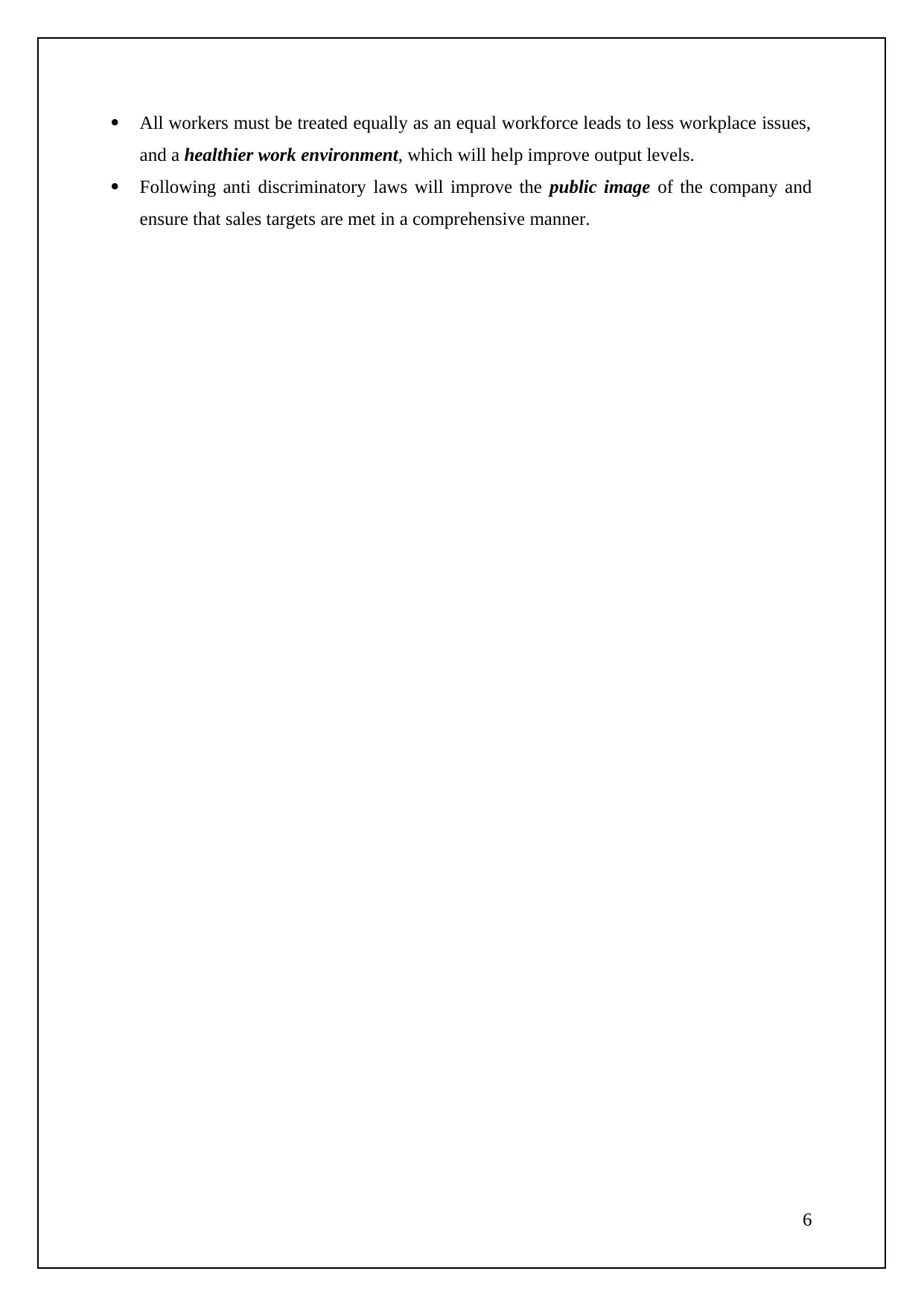
All workers must be treated equally as an equal workforce leads to less workplace issues,
and a healthier work environment, which will help improve output levels.
Following anti discriminatory laws will improve the public image of the company and
ensure that sales targets are met in a comprehensive manner.
6
and a healthier work environment, which will help improve output levels.
Following anti discriminatory laws will improve the public image of the company and
ensure that sales targets are met in a comprehensive manner.
6
⊘ This is a preview!⊘
Do you want full access?
Subscribe today to unlock all pages.

Trusted by 1+ million students worldwide
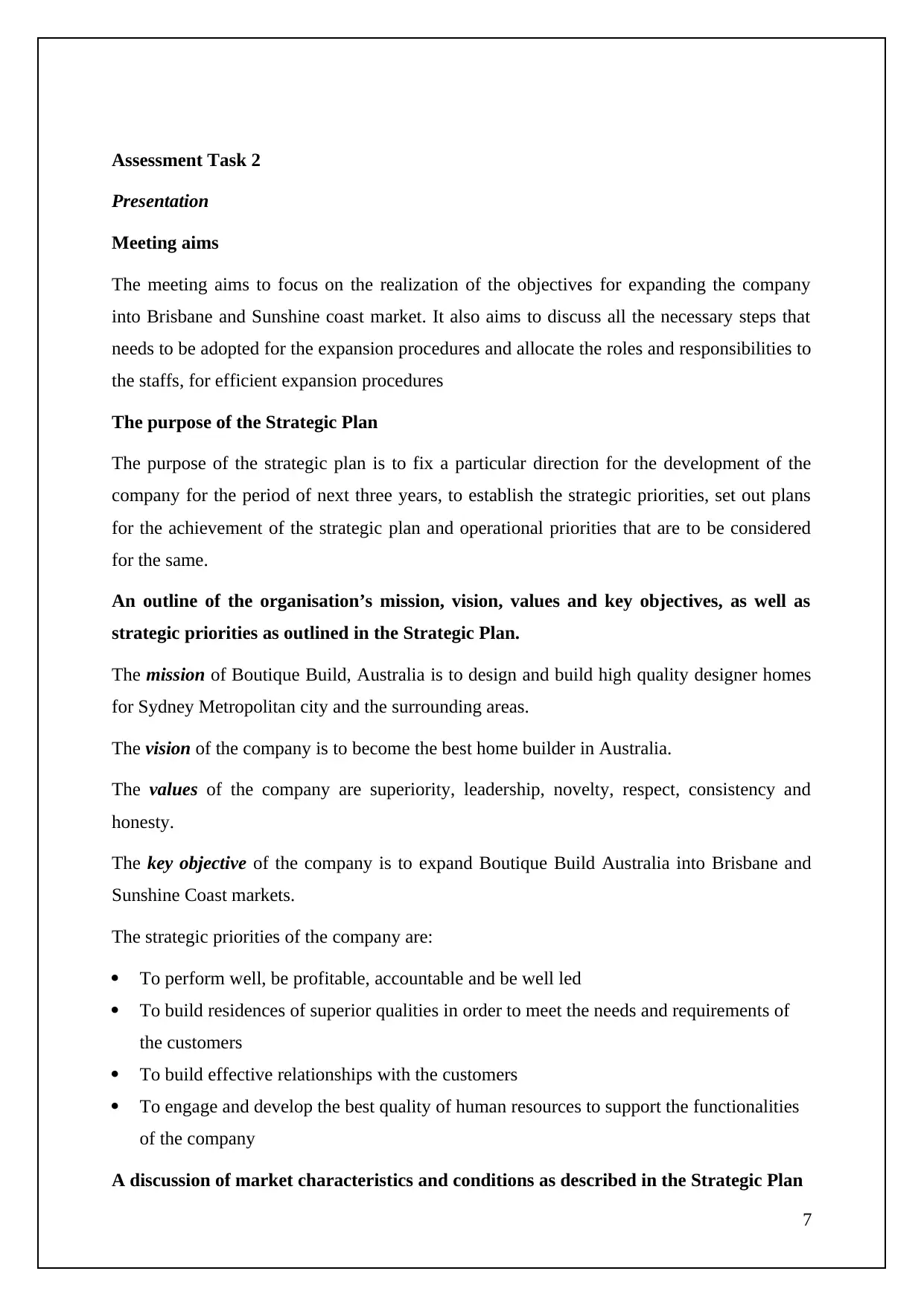
Assessment Task 2
Presentation
Meeting aims
The meeting aims to focus on the realization of the objectives for expanding the company
into Brisbane and Sunshine coast market. It also aims to discuss all the necessary steps that
needs to be adopted for the expansion procedures and allocate the roles and responsibilities to
the staffs, for efficient expansion procedures
The purpose of the Strategic Plan
The purpose of the strategic plan is to fix a particular direction for the development of the
company for the period of next three years, to establish the strategic priorities, set out plans
for the achievement of the strategic plan and operational priorities that are to be considered
for the same.
An outline of the organisation’s mission, vision, values and key objectives, as well as
strategic priorities as outlined in the Strategic Plan.
The mission of Boutique Build, Australia is to design and build high quality designer homes
for Sydney Metropolitan city and the surrounding areas.
The vision of the company is to become the best home builder in Australia.
The values of the company are superiority, leadership, novelty, respect, consistency and
honesty.
The key objective of the company is to expand Boutique Build Australia into Brisbane and
Sunshine Coast markets.
The strategic priorities of the company are:
To perform well, be profitable, accountable and be well led
To build residences of superior qualities in order to meet the needs and requirements of
the customers
To build effective relationships with the customers
To engage and develop the best quality of human resources to support the functionalities
of the company
A discussion of market characteristics and conditions as described in the Strategic Plan
7
Presentation
Meeting aims
The meeting aims to focus on the realization of the objectives for expanding the company
into Brisbane and Sunshine coast market. It also aims to discuss all the necessary steps that
needs to be adopted for the expansion procedures and allocate the roles and responsibilities to
the staffs, for efficient expansion procedures
The purpose of the Strategic Plan
The purpose of the strategic plan is to fix a particular direction for the development of the
company for the period of next three years, to establish the strategic priorities, set out plans
for the achievement of the strategic plan and operational priorities that are to be considered
for the same.
An outline of the organisation’s mission, vision, values and key objectives, as well as
strategic priorities as outlined in the Strategic Plan.
The mission of Boutique Build, Australia is to design and build high quality designer homes
for Sydney Metropolitan city and the surrounding areas.
The vision of the company is to become the best home builder in Australia.
The values of the company are superiority, leadership, novelty, respect, consistency and
honesty.
The key objective of the company is to expand Boutique Build Australia into Brisbane and
Sunshine Coast markets.
The strategic priorities of the company are:
To perform well, be profitable, accountable and be well led
To build residences of superior qualities in order to meet the needs and requirements of
the customers
To build effective relationships with the customers
To engage and develop the best quality of human resources to support the functionalities
of the company
A discussion of market characteristics and conditions as described in the Strategic Plan
7
Paraphrase This Document
Need a fresh take? Get an instant paraphrase of this document with our AI Paraphraser
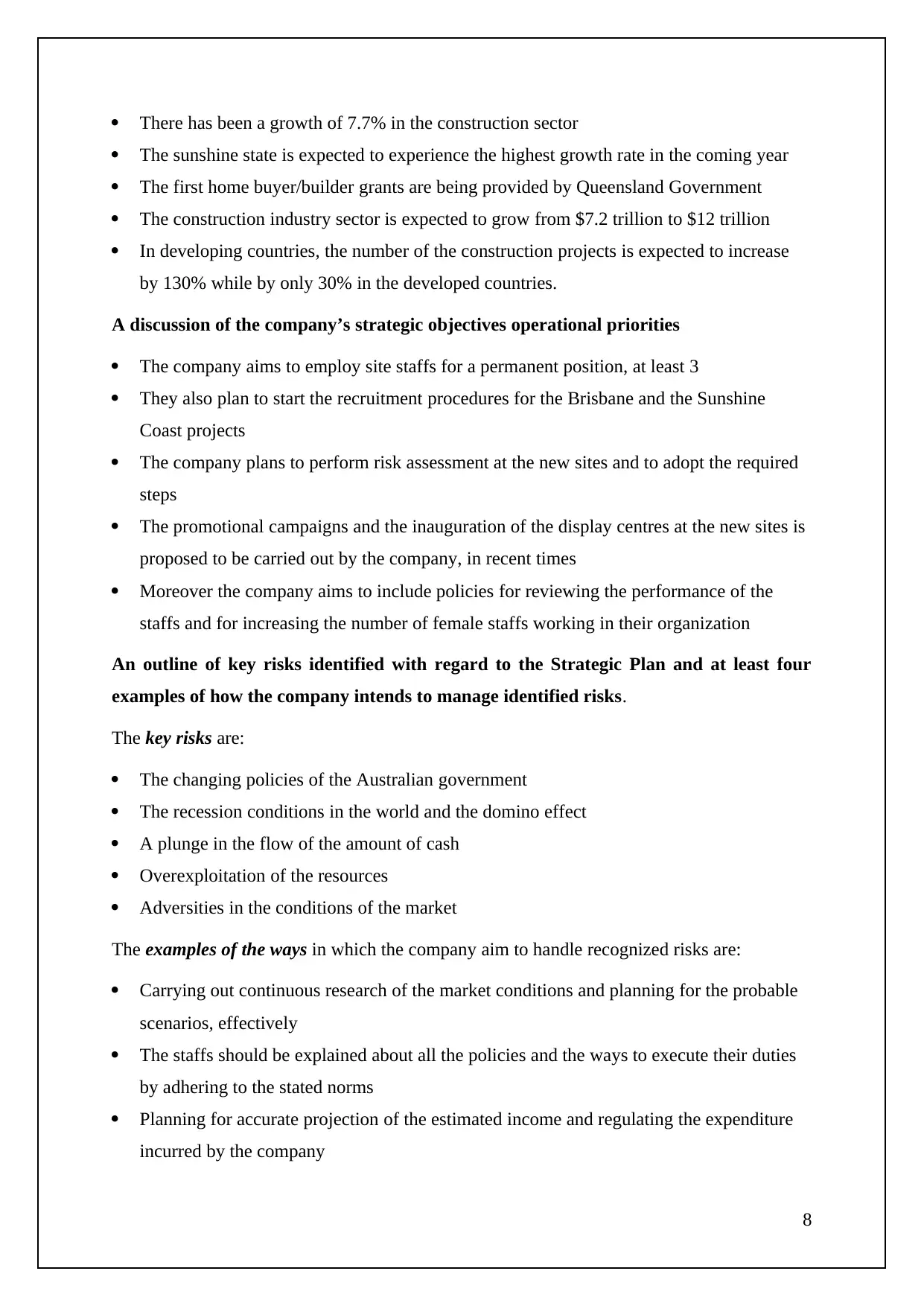
There has been a growth of 7.7% in the construction sector
The sunshine state is expected to experience the highest growth rate in the coming year
The first home buyer/builder grants are being provided by Queensland Government
The construction industry sector is expected to grow from $7.2 trillion to $12 trillion
In developing countries, the number of the construction projects is expected to increase
by 130% while by only 30% in the developed countries.
A discussion of the company’s strategic objectives operational priorities
The company aims to employ site staffs for a permanent position, at least 3
They also plan to start the recruitment procedures for the Brisbane and the Sunshine
Coast projects
The company plans to perform risk assessment at the new sites and to adopt the required
steps
The promotional campaigns and the inauguration of the display centres at the new sites is
proposed to be carried out by the company, in recent times
Moreover the company aims to include policies for reviewing the performance of the
staffs and for increasing the number of female staffs working in their organization
An outline of key risks identified with regard to the Strategic Plan and at least four
examples of how the company intends to manage identified risks.
The key risks are:
The changing policies of the Australian government
The recession conditions in the world and the domino effect
A plunge in the flow of the amount of cash
Overexploitation of the resources
Adversities in the conditions of the market
The examples of the ways in which the company aim to handle recognized risks are:
Carrying out continuous research of the market conditions and planning for the probable
scenarios, effectively
The staffs should be explained about all the policies and the ways to execute their duties
by adhering to the stated norms
Planning for accurate projection of the estimated income and regulating the expenditure
incurred by the company
8
The sunshine state is expected to experience the highest growth rate in the coming year
The first home buyer/builder grants are being provided by Queensland Government
The construction industry sector is expected to grow from $7.2 trillion to $12 trillion
In developing countries, the number of the construction projects is expected to increase
by 130% while by only 30% in the developed countries.
A discussion of the company’s strategic objectives operational priorities
The company aims to employ site staffs for a permanent position, at least 3
They also plan to start the recruitment procedures for the Brisbane and the Sunshine
Coast projects
The company plans to perform risk assessment at the new sites and to adopt the required
steps
The promotional campaigns and the inauguration of the display centres at the new sites is
proposed to be carried out by the company, in recent times
Moreover the company aims to include policies for reviewing the performance of the
staffs and for increasing the number of female staffs working in their organization
An outline of key risks identified with regard to the Strategic Plan and at least four
examples of how the company intends to manage identified risks.
The key risks are:
The changing policies of the Australian government
The recession conditions in the world and the domino effect
A plunge in the flow of the amount of cash
Overexploitation of the resources
Adversities in the conditions of the market
The examples of the ways in which the company aim to handle recognized risks are:
Carrying out continuous research of the market conditions and planning for the probable
scenarios, effectively
The staffs should be explained about all the policies and the ways to execute their duties
by adhering to the stated norms
Planning for accurate projection of the estimated income and regulating the expenditure
incurred by the company
8
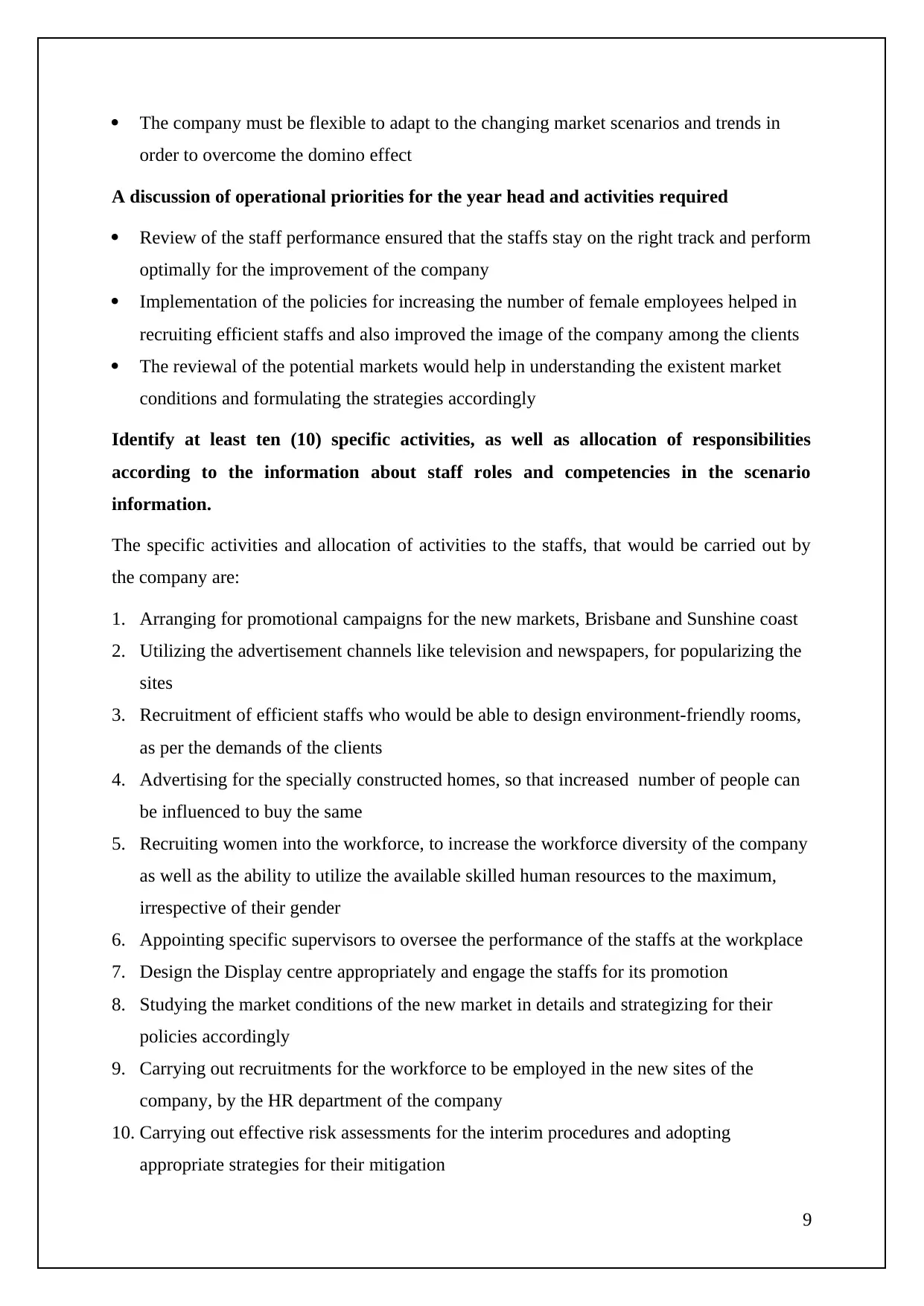
The company must be flexible to adapt to the changing market scenarios and trends in
order to overcome the domino effect
A discussion of operational priorities for the year head and activities required
Review of the staff performance ensured that the staffs stay on the right track and perform
optimally for the improvement of the company
Implementation of the policies for increasing the number of female employees helped in
recruiting efficient staffs and also improved the image of the company among the clients
The reviewal of the potential markets would help in understanding the existent market
conditions and formulating the strategies accordingly
Identify at least ten (10) specific activities, as well as allocation of responsibilities
according to the information about staff roles and competencies in the scenario
information.
The specific activities and allocation of activities to the staffs, that would be carried out by
the company are:
1. Arranging for promotional campaigns for the new markets, Brisbane and Sunshine coast
2. Utilizing the advertisement channels like television and newspapers, for popularizing the
sites
3. Recruitment of efficient staffs who would be able to design environment-friendly rooms,
as per the demands of the clients
4. Advertising for the specially constructed homes, so that increased number of people can
be influenced to buy the same
5. Recruiting women into the workforce, to increase the workforce diversity of the company
as well as the ability to utilize the available skilled human resources to the maximum,
irrespective of their gender
6. Appointing specific supervisors to oversee the performance of the staffs at the workplace
7. Design the Display centre appropriately and engage the staffs for its promotion
8. Studying the market conditions of the new market in details and strategizing for their
policies accordingly
9. Carrying out recruitments for the workforce to be employed in the new sites of the
company, by the HR department of the company
10. Carrying out effective risk assessments for the interim procedures and adopting
appropriate strategies for their mitigation
9
order to overcome the domino effect
A discussion of operational priorities for the year head and activities required
Review of the staff performance ensured that the staffs stay on the right track and perform
optimally for the improvement of the company
Implementation of the policies for increasing the number of female employees helped in
recruiting efficient staffs and also improved the image of the company among the clients
The reviewal of the potential markets would help in understanding the existent market
conditions and formulating the strategies accordingly
Identify at least ten (10) specific activities, as well as allocation of responsibilities
according to the information about staff roles and competencies in the scenario
information.
The specific activities and allocation of activities to the staffs, that would be carried out by
the company are:
1. Arranging for promotional campaigns for the new markets, Brisbane and Sunshine coast
2. Utilizing the advertisement channels like television and newspapers, for popularizing the
sites
3. Recruitment of efficient staffs who would be able to design environment-friendly rooms,
as per the demands of the clients
4. Advertising for the specially constructed homes, so that increased number of people can
be influenced to buy the same
5. Recruiting women into the workforce, to increase the workforce diversity of the company
as well as the ability to utilize the available skilled human resources to the maximum,
irrespective of their gender
6. Appointing specific supervisors to oversee the performance of the staffs at the workplace
7. Design the Display centre appropriately and engage the staffs for its promotion
8. Studying the market conditions of the new market in details and strategizing for their
policies accordingly
9. Carrying out recruitments for the workforce to be employed in the new sites of the
company, by the HR department of the company
10. Carrying out effective risk assessments for the interim procedures and adopting
appropriate strategies for their mitigation
9
⊘ This is a preview!⊘
Do you want full access?
Subscribe today to unlock all pages.

Trusted by 1+ million students worldwide
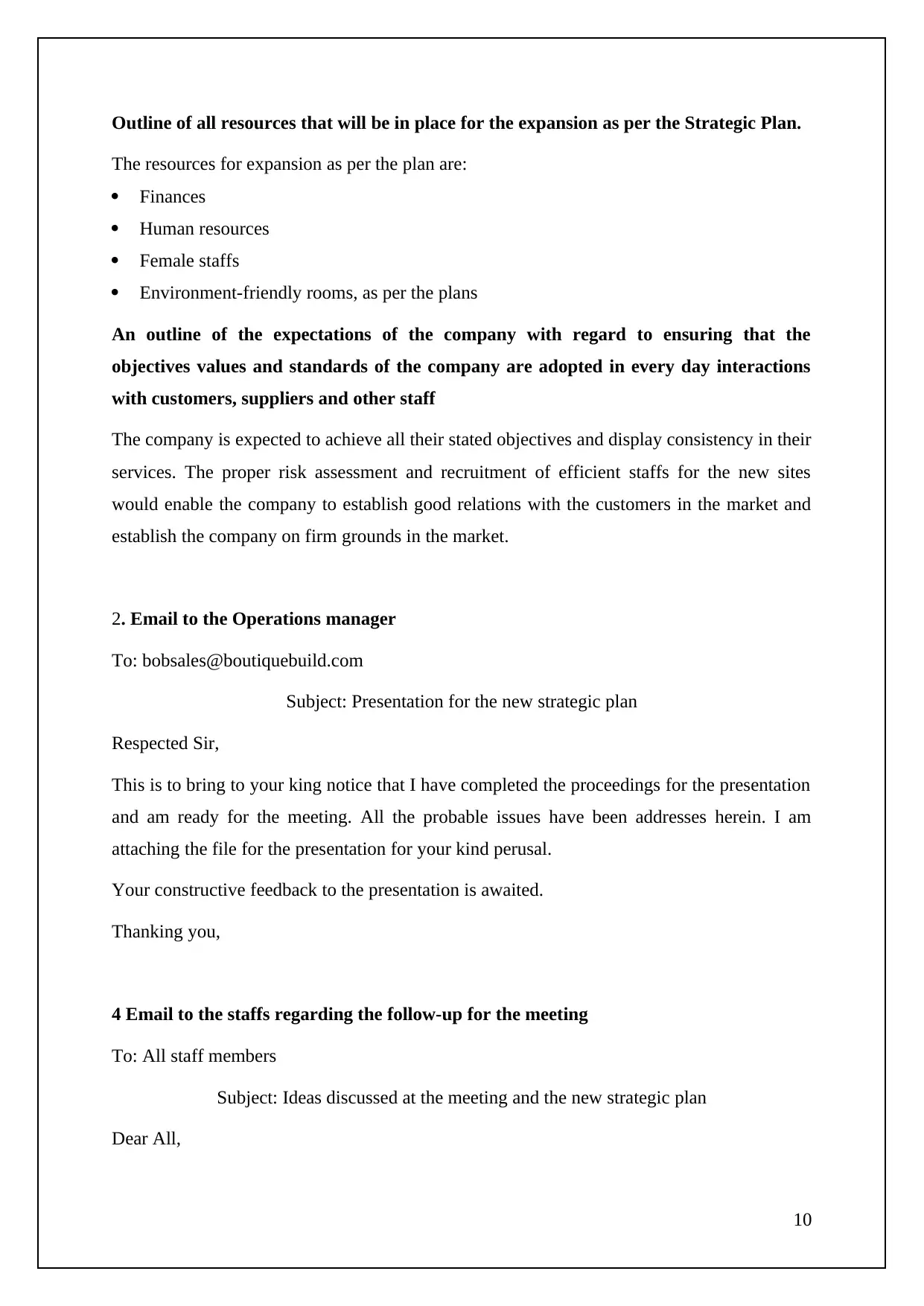
Outline of all resources that will be in place for the expansion as per the Strategic Plan.
The resources for expansion as per the plan are:
Finances
Human resources
Female staffs
Environment-friendly rooms, as per the plans
An outline of the expectations of the company with regard to ensuring that the
objectives values and standards of the company are adopted in every day interactions
with customers, suppliers and other staff
The company is expected to achieve all their stated objectives and display consistency in their
services. The proper risk assessment and recruitment of efficient staffs for the new sites
would enable the company to establish good relations with the customers in the market and
establish the company on firm grounds in the market.
2. Email to the Operations manager
To: bobsales@boutiquebuild.com
Subject: Presentation for the new strategic plan
Respected Sir,
This is to bring to your king notice that I have completed the proceedings for the presentation
and am ready for the meeting. All the probable issues have been addresses herein. I am
attaching the file for the presentation for your kind perusal.
Your constructive feedback to the presentation is awaited.
Thanking you,
4 Email to the staffs regarding the follow-up for the meeting
To: All staff members
Subject: Ideas discussed at the meeting and the new strategic plan
Dear All,
10
The resources for expansion as per the plan are:
Finances
Human resources
Female staffs
Environment-friendly rooms, as per the plans
An outline of the expectations of the company with regard to ensuring that the
objectives values and standards of the company are adopted in every day interactions
with customers, suppliers and other staff
The company is expected to achieve all their stated objectives and display consistency in their
services. The proper risk assessment and recruitment of efficient staffs for the new sites
would enable the company to establish good relations with the customers in the market and
establish the company on firm grounds in the market.
2. Email to the Operations manager
To: bobsales@boutiquebuild.com
Subject: Presentation for the new strategic plan
Respected Sir,
This is to bring to your king notice that I have completed the proceedings for the presentation
and am ready for the meeting. All the probable issues have been addresses herein. I am
attaching the file for the presentation for your kind perusal.
Your constructive feedback to the presentation is awaited.
Thanking you,
4 Email to the staffs regarding the follow-up for the meeting
To: All staff members
Subject: Ideas discussed at the meeting and the new strategic plan
Dear All,
10
Paraphrase This Document
Need a fresh take? Get an instant paraphrase of this document with our AI Paraphraser
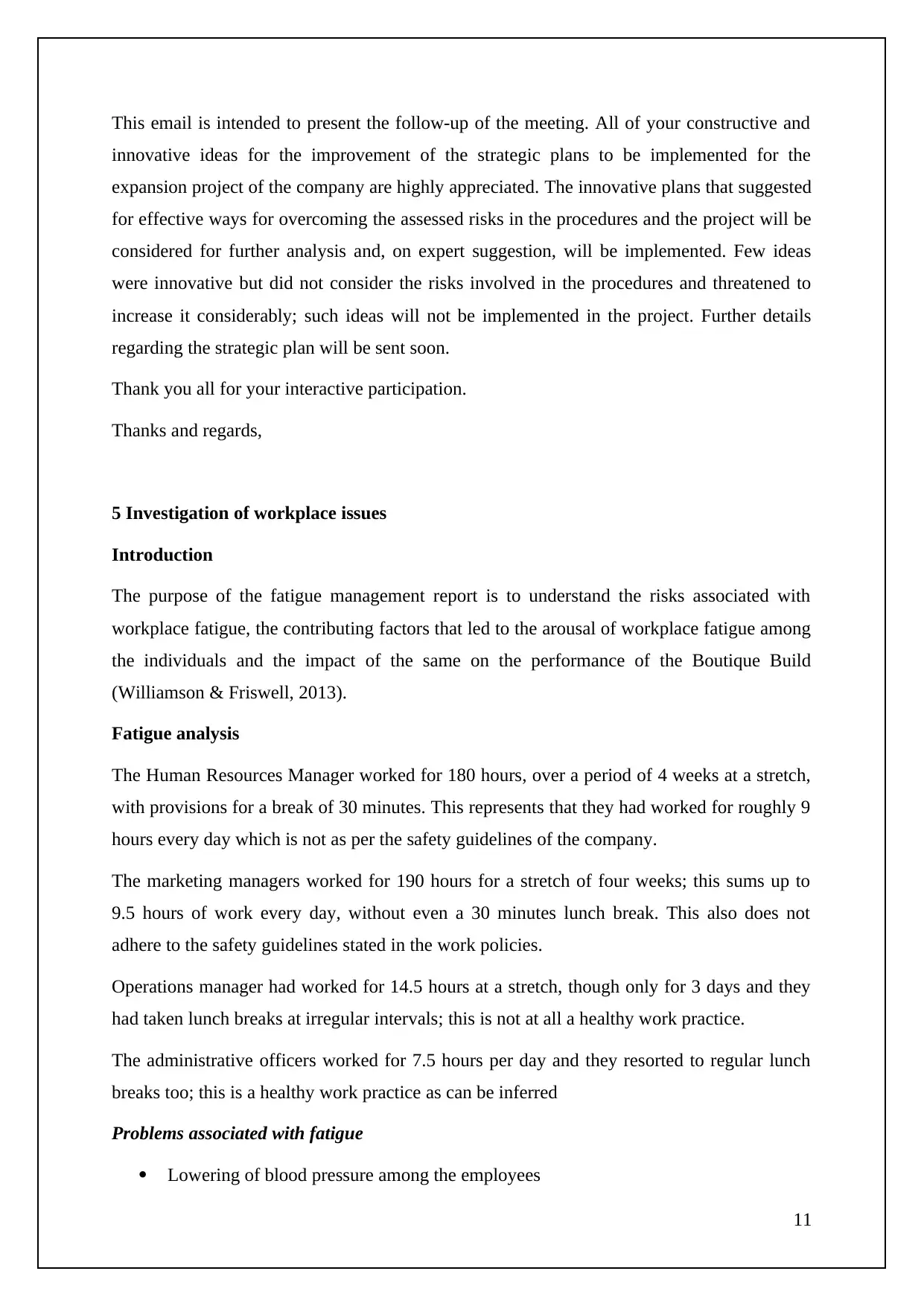
This email is intended to present the follow-up of the meeting. All of your constructive and
innovative ideas for the improvement of the strategic plans to be implemented for the
expansion project of the company are highly appreciated. The innovative plans that suggested
for effective ways for overcoming the assessed risks in the procedures and the project will be
considered for further analysis and, on expert suggestion, will be implemented. Few ideas
were innovative but did not consider the risks involved in the procedures and threatened to
increase it considerably; such ideas will not be implemented in the project. Further details
regarding the strategic plan will be sent soon.
Thank you all for your interactive participation.
Thanks and regards,
5 Investigation of workplace issues
Introduction
The purpose of the fatigue management report is to understand the risks associated with
workplace fatigue, the contributing factors that led to the arousal of workplace fatigue among
the individuals and the impact of the same on the performance of the Boutique Build
(Williamson & Friswell, 2013).
Fatigue analysis
The Human Resources Manager worked for 180 hours, over a period of 4 weeks at a stretch,
with provisions for a break of 30 minutes. This represents that they had worked for roughly 9
hours every day which is not as per the safety guidelines of the company.
The marketing managers worked for 190 hours for a stretch of four weeks; this sums up to
9.5 hours of work every day, without even a 30 minutes lunch break. This also does not
adhere to the safety guidelines stated in the work policies.
Operations manager had worked for 14.5 hours at a stretch, though only for 3 days and they
had taken lunch breaks at irregular intervals; this is not at all a healthy work practice.
The administrative officers worked for 7.5 hours per day and they resorted to regular lunch
breaks too; this is a healthy work practice as can be inferred
Problems associated with fatigue
Lowering of blood pressure among the employees
11
innovative ideas for the improvement of the strategic plans to be implemented for the
expansion project of the company are highly appreciated. The innovative plans that suggested
for effective ways for overcoming the assessed risks in the procedures and the project will be
considered for further analysis and, on expert suggestion, will be implemented. Few ideas
were innovative but did not consider the risks involved in the procedures and threatened to
increase it considerably; such ideas will not be implemented in the project. Further details
regarding the strategic plan will be sent soon.
Thank you all for your interactive participation.
Thanks and regards,
5 Investigation of workplace issues
Introduction
The purpose of the fatigue management report is to understand the risks associated with
workplace fatigue, the contributing factors that led to the arousal of workplace fatigue among
the individuals and the impact of the same on the performance of the Boutique Build
(Williamson & Friswell, 2013).
Fatigue analysis
The Human Resources Manager worked for 180 hours, over a period of 4 weeks at a stretch,
with provisions for a break of 30 minutes. This represents that they had worked for roughly 9
hours every day which is not as per the safety guidelines of the company.
The marketing managers worked for 190 hours for a stretch of four weeks; this sums up to
9.5 hours of work every day, without even a 30 minutes lunch break. This also does not
adhere to the safety guidelines stated in the work policies.
Operations manager had worked for 14.5 hours at a stretch, though only for 3 days and they
had taken lunch breaks at irregular intervals; this is not at all a healthy work practice.
The administrative officers worked for 7.5 hours per day and they resorted to regular lunch
breaks too; this is a healthy work practice as can be inferred
Problems associated with fatigue
Lowering of blood pressure among the employees
11
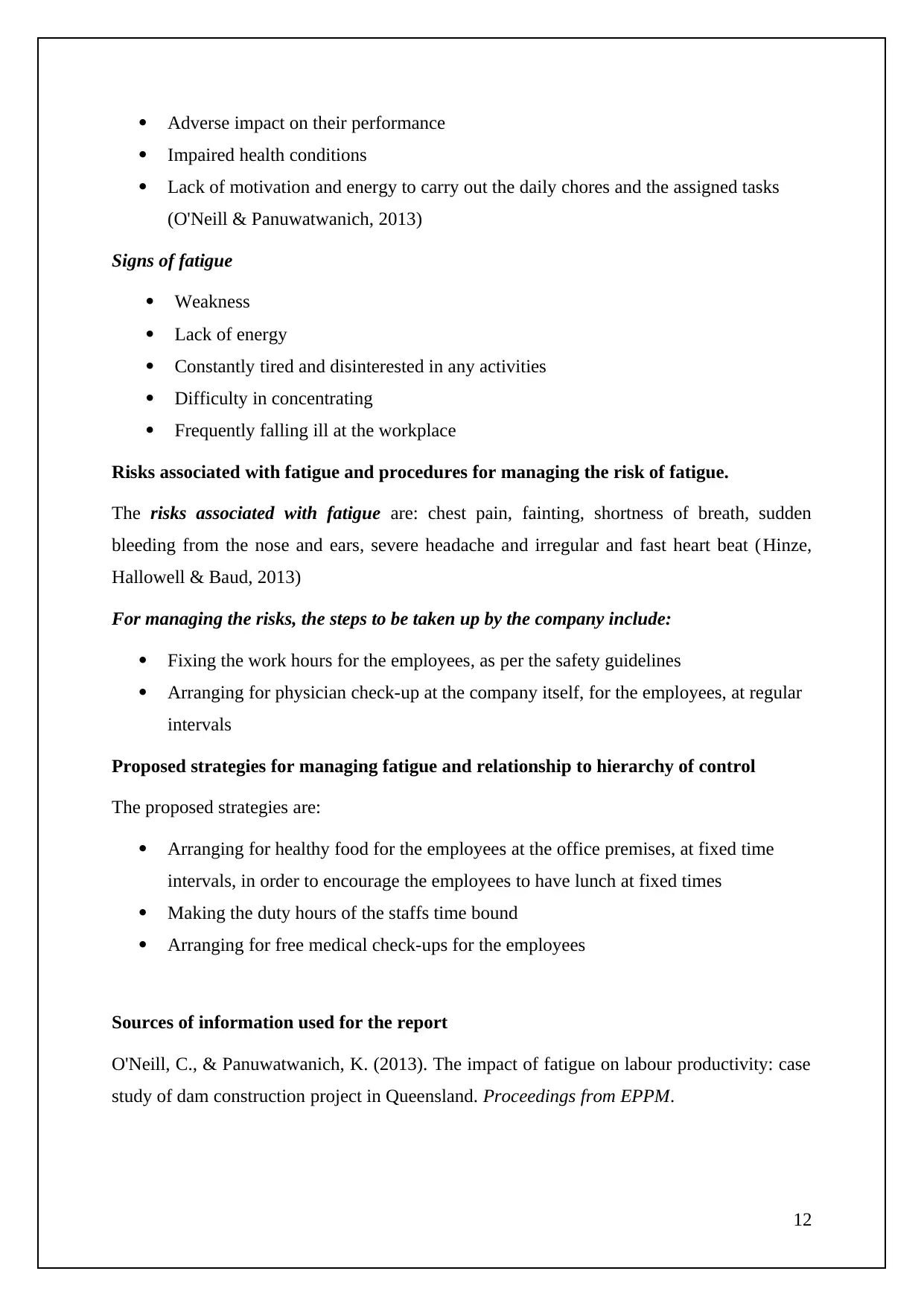
Adverse impact on their performance
Impaired health conditions
Lack of motivation and energy to carry out the daily chores and the assigned tasks
(O'Neill & Panuwatwanich, 2013)
Signs of fatigue
Weakness
Lack of energy
Constantly tired and disinterested in any activities
Difficulty in concentrating
Frequently falling ill at the workplace
Risks associated with fatigue and procedures for managing the risk of fatigue.
The risks associated with fatigue are: chest pain, fainting, shortness of breath, sudden
bleeding from the nose and ears, severe headache and irregular and fast heart beat (Hinze,
Hallowell & Baud, 2013)
For managing the risks, the steps to be taken up by the company include:
Fixing the work hours for the employees, as per the safety guidelines
Arranging for physician check-up at the company itself, for the employees, at regular
intervals
Proposed strategies for managing fatigue and relationship to hierarchy of control
The proposed strategies are:
Arranging for healthy food for the employees at the office premises, at fixed time
intervals, in order to encourage the employees to have lunch at fixed times
Making the duty hours of the staffs time bound
Arranging for free medical check-ups for the employees
Sources of information used for the report
O'Neill, C., & Panuwatwanich, K. (2013). The impact of fatigue on labour productivity: case
study of dam construction project in Queensland. Proceedings from EPPM.
12
Impaired health conditions
Lack of motivation and energy to carry out the daily chores and the assigned tasks
(O'Neill & Panuwatwanich, 2013)
Signs of fatigue
Weakness
Lack of energy
Constantly tired and disinterested in any activities
Difficulty in concentrating
Frequently falling ill at the workplace
Risks associated with fatigue and procedures for managing the risk of fatigue.
The risks associated with fatigue are: chest pain, fainting, shortness of breath, sudden
bleeding from the nose and ears, severe headache and irregular and fast heart beat (Hinze,
Hallowell & Baud, 2013)
For managing the risks, the steps to be taken up by the company include:
Fixing the work hours for the employees, as per the safety guidelines
Arranging for physician check-up at the company itself, for the employees, at regular
intervals
Proposed strategies for managing fatigue and relationship to hierarchy of control
The proposed strategies are:
Arranging for healthy food for the employees at the office premises, at fixed time
intervals, in order to encourage the employees to have lunch at fixed times
Making the duty hours of the staffs time bound
Arranging for free medical check-ups for the employees
Sources of information used for the report
O'Neill, C., & Panuwatwanich, K. (2013). The impact of fatigue on labour productivity: case
study of dam construction project in Queensland. Proceedings from EPPM.
12
⊘ This is a preview!⊘
Do you want full access?
Subscribe today to unlock all pages.

Trusted by 1+ million students worldwide
1 out of 26
Related Documents
Your All-in-One AI-Powered Toolkit for Academic Success.
+13062052269
info@desklib.com
Available 24*7 on WhatsApp / Email
![[object Object]](/_next/static/media/star-bottom.7253800d.svg)
Unlock your academic potential
Copyright © 2020–2025 A2Z Services. All Rights Reserved. Developed and managed by ZUCOL.





